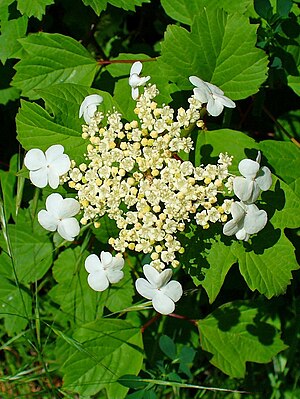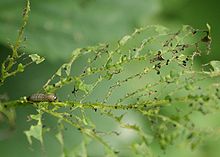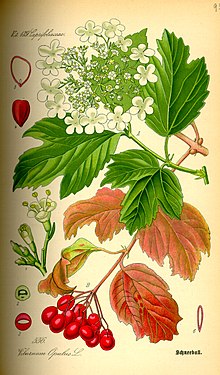Ordinary snowball
| Ordinary snowball | ||||||||||||
|---|---|---|---|---|---|---|---|---|---|---|---|---|

Common snowball ( Viburnum opulus ) |
||||||||||||
| Systematics | ||||||||||||
|
||||||||||||
| Scientific name | ||||||||||||
| Viburnum opulus | ||||||||||||
| L. |
The common snowball ( Viburnum opulus ), also called snowball , heartberry, bloodberry, steamberry, blackberry bush, goat's ball, glass berry, snakeberry, water holder, water snowball, is a species of snowballs ( viburnum ) in the musk herb family ( Adoxaceae). It is widespread in Eurasia and is used as an ornamental wood .
description
Appearance and bark
The common snowball grows as a deciduous shrub and can reach heights of 1.5 to 6 meters. The 4 to 6 mm long stalked winter bud has two pairs of fused, bare bud scales, the inner ones being membranous and fused with tubes at their base.
The thin to thick bark can be corky. The twigs, which are blunt-edged in the first year, have a greenish-brown or sometimes reddish, bald to downy hairy bark with conspicuously raised lenticels . From the second year onwards, the branches are round with stems and have a yellowish or red-brown and bare bark with scattered, small, rounded lenticels.
leaf
The ever against constantly arranged leaves are divided into leaf blade and petiole. The green or reddish, strong petiole is 1 to 5 cm long, glabrous or hairy and has two to four or more disc-shaped glands near its base. With a length of 6 to 12 cm and a width of 5 to 10 cm, the parchment-like leaf blades are circular-ovoid to broad-ovoid or obovate with a rounded, truncated or slightly heart-shaped base and they are usually three, rarely five-lobed . The end lobe is often the largest, and the side lobes sometimes spread outward. The ends of the leaf lobes are pointed. The leaf margin is serrated irregularly. The leaf surfaces are colored the same green on both sides from the start. On the underside of the leaf there are splaying hairs, especially on the leaf veins . The upper side of the leaf is largely bare. There is a hand vein. The central vein is raised on the underside of the leaf. The leaf veins are straight or slightly curved, branched and end in the leaf teeth. The leaves in the upper part of the branches are often narrower and longer, as well as elliptical to oblong-lanceolate and unlobed to slightly three-lobed or slightly notched; their leaf lobes are more or less entire and the middle lobe is elongated, the side lobes are short. The leaves at the ends of the branches are sometimes unlapped. The two durable stipules are awl-shaped with a length of 1 to 5 mm.
Inflorescence and flower
The flowers appear after the leaves and the flowering period extends from May to June in China and from May to August in Central Europe. The terminal inflorescence stem is strong, hairless or hairy and 2 to 5 cm long. Zymous partial inflorescences are grouped together in a compound, trugdoldigen total inflorescence , which has a diameter of 5 to 12 cm . The obsolete bracts and bracts are leaf-like, green, lanceolate and glabrous or sparsely hairy. At the first node of the inflorescence axis there are six to eight bald or with simple hair provided "rays" (branches), which carry five to ten long-stalked, large, sterile, fragrant marginal flowers; they are located on the outside of the inflorescence and serve as a conspicuous display device. In the 'Roseum' variety, the inflorescence contains only sterile, large flowers. On the "rays" of the second and third order there are very short-stalked, clearly smaller, non-fragrant, fertile flowers; they are in the inflorescence in the supervision inside.
The flowers are five-fold with a double flower envelope . The five green, bare sepals are fused into an inverted conical calyx tube about 1 mm long, which end in five triangular calyx teeth with a length of about 0.6 mm with a blunt tip; this is about the same for the sterile and fertile flowers. In the sterile flowers, the five white petals are fused and the five unequal corolla lobes are broad, obovate with a rounded upper end; overall they form a conspicuous crown with a diameter of 1.3 to 2.5 cm. No gynoeceum and androeceum are developed in the sterile flowers . In the fertile flowers, the five white petals are fused into a 1 to 2 mm long corolla tube and the five somewhat unequal corolla lobes, bald on the outside and fluffy hairy on the inside, have a diameter of almost circular and are spread out or bent back with a rounded upper end and a smooth edge; together they form a disc with a diameter of 4 to 5 mm. There is only the outer circle with five fertile stamens . The thin, about 4 mm long stamens are inserted near the base of the corolla and protrude clearly above it. The yellowish-white or purple-colored anthers are about 1 mm long. The half under constant ovary is dreikammerig, but only one ovary chamber is fertile and it contains only one ovule . The short style ends in a two-lobed scar and slightly protrudes over the calyx.
fruit
The bald, berry-like stone fruit has both a rounded base and a tip and contains only one stone core. With a diameter of 8 to 10 (rarely up to 12) mm, the stone core is almost circular and flattened with a rounded upper end. The fruits ripen in Central Europe from August to November, in China between September and October, and first turn yellow and then red.
Chromosome number
The basic chromosome number is x = 9; there is diploidy , 2n = 18. This also applies to the subspecies Viburnum opulus subsp. calvescens and Viburnum opulus subsp. trilobum as well as for the variety "Roseum".
ecology
The common snowball is a winter-bare shrub and an intensive and shallow root with VA mycorrhiza .
The inflorescences are homogeneous, bowl-shaped "disc flowers". The sterile marginal flowers are greatly enlarged and serve as a display device. The nectar is presented openly in the fertile flowers. Pollinators are insects of various species (except butterflies ), especially flies , which, similar to the umbellifers, perform pollination by walking around on the inflorescence . Spontaneous self-pollination is also successful.
The fruit ripening of the berry-like stone fruit is between August and November. The fruits are winter dwellers with digestive spread. They are found by some birds, e.g. B. shunned by thrushes , but eaten by other birds during the winter. The crushed fruits have a distinct odor of sweat.
A vegetative propagation can be done, because deep in the earth to grow ambitious branches by itself.


Occurrence
The common snowball ( Viburnum opulus L. subsp. Opulus ) is common throughout Europe, West and North Asia. The neophyte is Viburnum opulus subsp. opulus also occurs in parts of North America.
Viburnum opulus L. subsp. opulus can be found in Central Europe from the plains to the Alps at altitudes of around 1000 meters. In the Allgäu Alps, this clan rises to an altitude of 1,100 meters. The common snowball is found mainly on damp bushes, the banks of streams, rivers and lakes and on the edges of forests. In Central Europe it is a character species of the Salici-Viburnetum opuli from the Berberidion association, but also occurs in societies of the order Prunetalia or the associations Salicion cinereae or Alno-Ulmion.
Systematics
The first description of Viburnum opulus was made in 1753 by Carl Linnaeus in Species Plantarum , Volume 1, page 268. synonyms for Viburnum opulus L. are: Opulus vulgaris Borkh. in Rome. nom. illeg., Opulus lobatofolia Gilib. nom. invalid., Viburnum lobatum Lam. nom. illeg., Viburnum glandulosum Salisb. nom. illeg., Opulus palustris Gray nom. illeg., Opulus glandulosus Moench .
Viburnum opulus is one of about five to six species of the circumboreal section Opulus within the genus Viburnum .
There are two or three subspecies of the species Viburnum opulus . They are also considered species by some authors.
- Viburnum opulus subsp. calvescens (Rehder) Sugimoto (Syn .: Viburnum sargentii Koehne var. calvescens Rehder , Viburnum opulus var. calvescens (Rehder) H. Hara , Viburnum opulus f. intermedium (Nakai) Sugimoto , Viburnum opulus f. puberulum (Komarov) Sugimoto , Viburnum opulus . var pubinerve Makino ; Viburnum opulus var. sargentii (Koehne) Takeda , Viburnum pubinerve flower ex Nakai , Viburnum pubinerve f. calvescens (Rehder) Nakai , Viburnum pubinerve f. intermedium Nakai , Viburnum pubinerve f. puberulum (Komarov) Nakai , Viburnum sargentii Koehne , Viburnum sargentii f. calvescens (Rehder) Rehder , Viburnum sargentii f. glabra Komarov , Viburnum sargentii f. intermedium (Nakai) H.Hara , Viburnum sargentii var. intermedium (Nakai) Kitagawa , Viburnum sargentii f. puberulum Komarov , Viburnum sargentii var. puberulum (Komarov) Kitagawa ): It occurs in Far Eastern Russia, Eastern Siberia, Mongolia, Korea, China and Japan.
- Viburnum opulus L. subsp. opulus : It occurs in Europe, in the Caucasus, in Central Asia, in western Siberia and in northwestern Zhejiang .
- American snowball ( Viburnum opulus subsp. Trilobum (Marshall) RTClausen , Syn .: Viburnum trilobum Marshall , Viburnum opulus var. Americanum Aiton ): It occurs in North America.
Ingredients and toxicity
The bark, leaves and unripe fruit contain oxalates , saponins , tannins , bitter substances , pectin and the glycoside viburnin .
As a poisonous plant, the snowball has the degree of toxicity "poisonous" , which, for example, also has the real St. John's wort . There are contradicting information about the toxicity of the berries in the literature ( slightly toxic to toxic ).
use
The drug from the bark is still used medicinally as an antispasmodic, especially for menstrual cramps. When cooked, the fruits can be used for jam or jelly. In parts of Eastern Europe , the ripe “berries” are also eaten raw.
In Eastern European countries, the red berries are crushed in hot water against colds and drunk sweetened with honey. They are sold in all small markets in the fall. The berries are usually harvested after the first frost and are only then considered ripe, presumably toxins are broken down by freezing. In addition, fructose crystallizes out when it is frosty, masking the otherwise strongly sourish-bitter taste.
The name steam berry comes from the fact that in the past the fruits were used in folk medicine as a remedy for “steam”, as asthma and shortness of breath were called at the time , also in Central Europe .
Especially in Turkey and especially in the central Anatolian city of Kayseri , the fruits are placed in barrels with tap water. The water in the barrels is changed once every 2 weeks. After a month or so, the pickled berries are “ripe” and are then squeezed, especially in summer, and mixed with water and sugar to make a tasty “ Gilaboru ” soft drink . This drink is said to have a healing effect on kidney stones.
The common snowball is also used as an ornamental plant in gardens, parks and grounds . The variety “Roseum” (syn .: Viburnum opulus f. Roseum (L.) Hegi , Viburnum opulus var. Roseum L. , Viburnum opulus var. Sterile DC. ), Which is also called garden snowball, is often used ; this has a spherical inflorescence with exclusively sterile flowers. The wild form is suitable for planting trees in wild plant gardens. Because of its high rash, it is easy to prune and use as a hedge plant.
Naming
The German trivial name snowball has been in use since the 17th century, as the sterile filled snowball with ball-shaped inflorescences ( Viburnum opulus cv. "Roseum") did not emerge until around 1594. More appropriate names were previously used: heart berries (because of the heart-shaped seeds), glass berries (because of the glassy-looking fruits), blood berries (because of the thick red fruit juice) and waterholder because the common snowball likes to grow near water and its flowers are similar to the flowers of the elder bush .

Parasites
The black bean louse in particular hibernates on the snowball in order to suckle the young shoots in spring. But other aphid species also prefer the common snowball.
The common snowball is the habitat and food source of the snowball leaf beetle ( Pyrrhalta viburni ), which specializes in snowball species . It occurs not only on one species of Viburnum , but on many, but only on species of the genus Viburnum .
swell
- Qiner Yang & Valéry Malécot: Viburnum : Viburnum opulus , p. 610 - the same text online as the printed work , In: Flora of China Editorial Committee: Wu Zheng-yi, Peter H. Raven & Deyuan Hong (eds.): Flora of China - Cucurbitaceae through Valerianaceae, with Annonaceae and Berberidaceae , Volume 19, Science Press and Missouri Botanical Garden Press, Beijing and St. Louis, February 28, 2011. ISBN 978-1-935641-04-9 (section description, distribution and classification)
Individual evidence
- ↑ Common snowball. In: FloraWeb.de.
- ↑ Viburnum opulus at Tropicos.org. In: IPCN Chromosome Reports . Missouri Botanical Garden, St. Louis
- ↑ a b c d Ruprecht Düll , Herfried Kutzelnigg : Pocket dictionary of plants in Germany and neighboring countries. The most common Central European species in portrait . 7th, corrected and enlarged edition. Quelle & Meyer, Wiebelsheim 2011, ISBN 978-3-494-01424-1 .
- ^ E. Hultén & M. Fries: Atlas of North European vascular plants , 1986.
- ↑ Erhard Dörr, Wolfgang Lippert : Flora of the Allgäu and its surroundings. Volume 2, IHW, Eching 2004, ISBN 3-930167-61-1 , p. 520.
- ^ Erich Oberdorfer : Plant-sociological excursion flora for Germany and neighboring areas . With the collaboration of Angelika Schwabe and Theo Müller. 8th, heavily revised and expanded edition. Eugen Ulmer, Stuttgart (Hohenheim) 2001, ISBN 3-8001-3131-5 , pp. 876 .
- ↑ First publication scanned at biodiversitylibrary.org .
- ↑ Viburnum opulus at Tropicos.org. Missouri Botanical Garden, St. Louis
- ↑ a b c d Viburnum opulus in the Germplasm Resources Information Network (GRIN), USDA , ARS , National Genetic Resources Program. National Germplasm Resources Laboratory, Beltsville, Maryland.
- ↑ Richard C. Winkworth & MJ Donoghue: Viburnum phylogeny based on combined molecular data: implications for taxonomy and biogeography , In: American Journal of Botany , Volume 92, Number 4, 2005, pp. 653-666: PDF .
- ^ E. von Raab-Straube (2017+): Viburnaceae. - In: Euro + Med Plantbase - the information resource for Euro-Mediterranean plant diversity. Data sheet Viburnaceae
- ^ Viburnum opulus , Institute for Veterinary Toxicology, University of Zurich, accessed on May 26, 2011.
- ↑ Hypericum perforatum , Institute for Veterinary Toxicology, University of Zurich, accessed on May 26, 2011.
- ^ Viburnum opulus - Botany , Institute for Veterinary Toxicology, University of Zurich, accessed on May 26, 2011.
- ^ Hunnius: Pharmaceutical Dictionary , deGruyter, 1993, ISBN 3110138689 , p. 1476
- ^ Andreas Schmeller: Bavarian Dictionary , 1837. P. 510
- ↑ Dericks-Tan, Vollbrecht: On the trail of the wild fruits in Europe , ISBN 978-3-00021129-4 , Abadi-Verlag 2009. p. 258
- ^ Paul A. Weston & E. Richard Hoebeke (Dept. of Entomology, Cornell University) & Brian C. Eshenaur (Cornell Cooperative Extension, Monroe County), 2008/2010: Viburnum Leaf Beetle - Pyrrhalta viburni (Paykull); Family: Chrysomelidae (PDF).
Web links
- Ordinary snowball. In: FloraWeb.de.
- Ordinary snowball . In: BiolFlor, the database of biological-ecological characteristics of the flora of Germany.
- Profile and distribution map for Bavaria . In: Botanical Information Hub of Bavaria .
- Viburnum opulus L. In: Info Flora , the national data and information center for Swiss flora . Retrieved March 29, 2016.
- Distribution in the northern hemisphere according to Eric Hultén
- Thomas Meyer: Snowball data sheet with identification key and photos at Flora-de: Flora von Deutschland (old name of the website: Flowers in Swabia )
- Pictures with details , uni-graz.at










